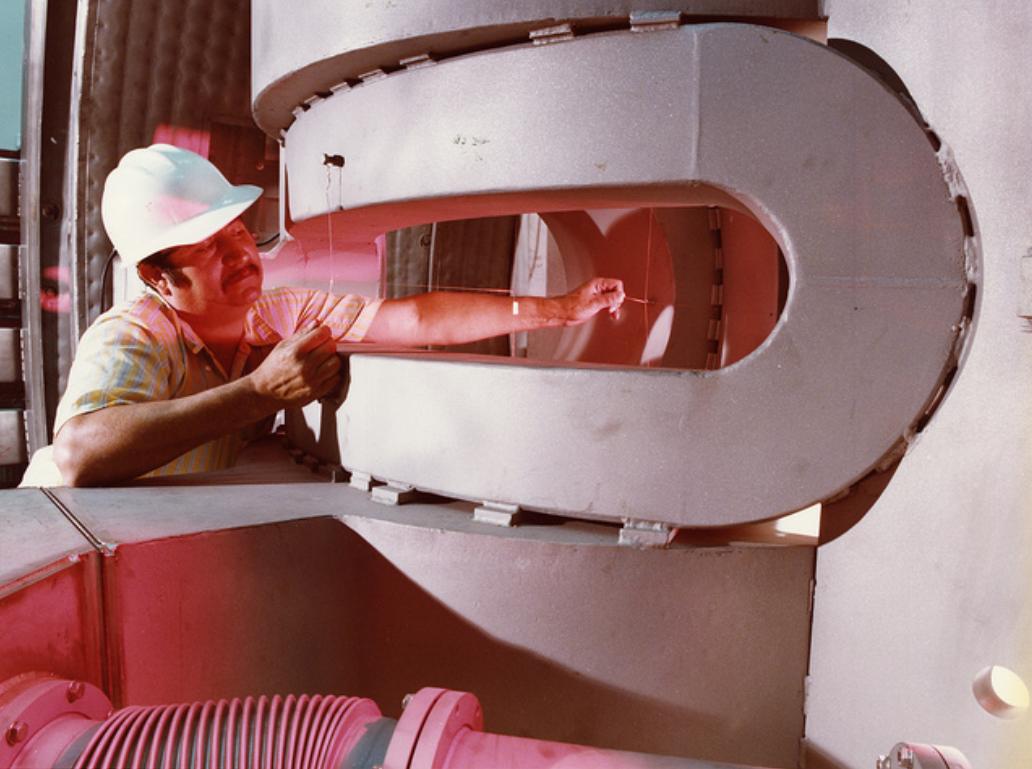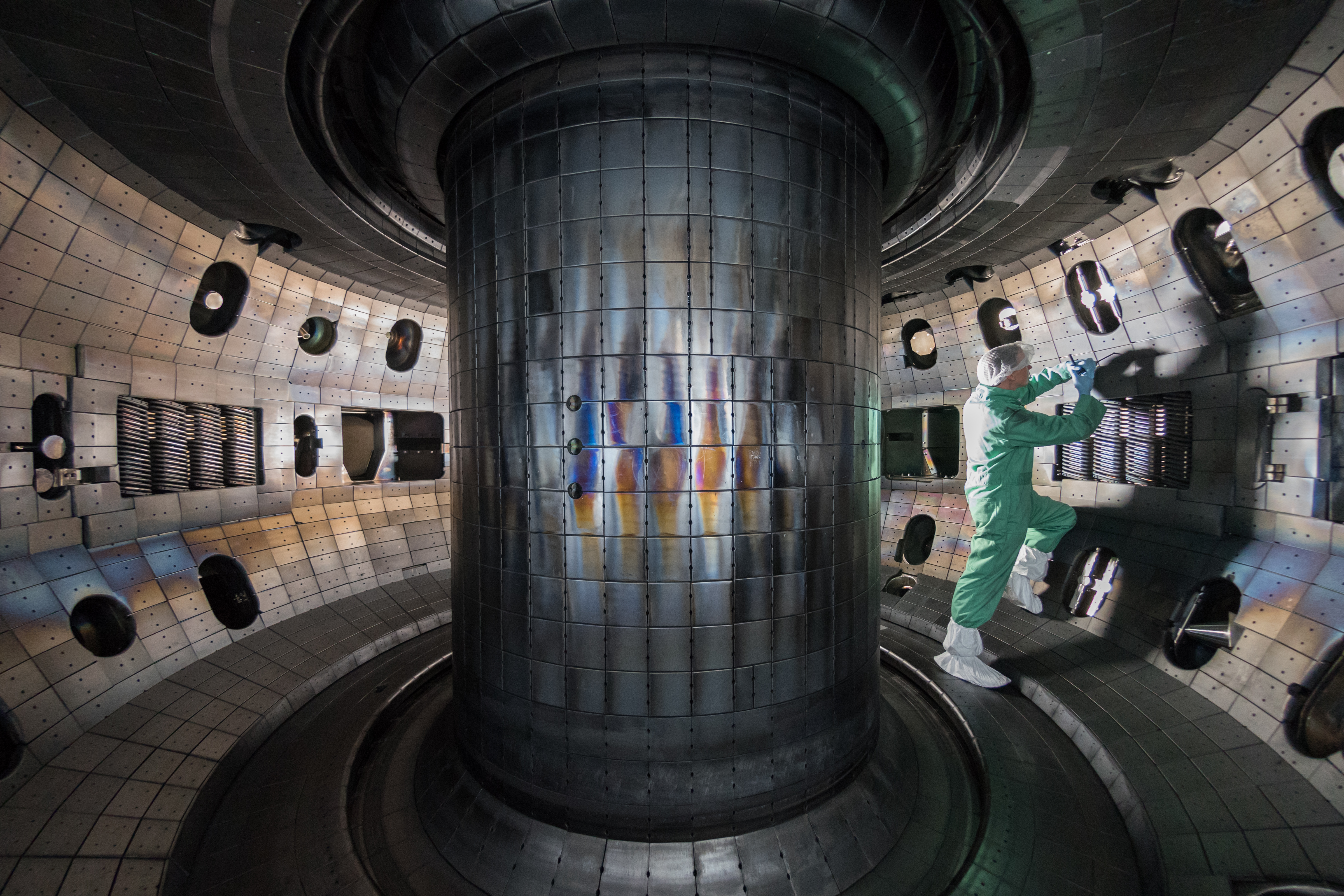|
Tandem Mirror Experiment
The Tandem Mirror Experiment (TMX and TMX-U) was a magnetic mirror machine operated from 1979 to 1987 at the Lawrence Livermore National Laboratory. It was the first large-scale machine to test the "tandem mirror" concept in which two mirrors trapped a large volume of plasma between them in an effort to increase the efficiency of the reactor. The original TMX was designed and built in a short period between its conception at a major physics meeting in Germany in October 1976, its design in January 1977, and its completion in October 1978. Over the next year, it validated the tandem mirror approach. Plans began to build a much larger machine based on the same principles, the Mirror Fusion Test Facility (MFTF). MFTF was initially just a scaled-up version of TMX, but when the design was studied it was seen that it would not reach its desired performance. Some system was needed that would boost the internal temperature of the fuel. A solution was found in the form of "thermal barrier ... [...More Info...] [...Related Items...] OR: [Wikipedia] [Google] [Baidu] |
Magnetic Mirror
A magnetic mirror, known as a magnetic trap (магнитный захват) in Russia and briefly as a pyrotron in the US, is a type of magnetic confinement device used in fusion power to trap high temperature plasma using magnetic fields. The mirror was one of the earliest major approaches to fusion power, along with the stellarator and z-pinch machines. In a classic magnetic mirror, a configuration of electromagnets is used to create an area with an increasing density of magnetic field lines at either end of the confinement area. Particles approaching the ends experience an increasing force that eventually causes them to reverse direction and return to the confinement area. This mirror effect will only occur for particles within a limited range of velocities and angles of approach, those outside the limits will escape, making mirrors inherently "leaky". An analysis of early fusion devices by Edward Teller pointed out that the basic mirror concept is inherently unstable. I ... [...More Info...] [...Related Items...] OR: [Wikipedia] [Google] [Baidu] |
Ioffe Institute
The Ioffe Physical-Technical Institute of the Russian Academy of Sciences (for short, Ioffe Institute, russian: Физико-технический институт им. А. Ф. Иоффе) is one of Russia's largest research centers specialized in physics and technology. The institute was established in 1918 in Petrograd (now St. Petersburg) and run for several decades by Abram Ioffe. The institute is a member of the Russian Academy of Sciences. Present structure of the institute As of 2019, the Ioffe institute employed about 1500 people, around 1000 of whom were scientific researchers (including 560 with a PhD degree and 250 with a Doktor Nauk degree). Most of the research staff members are top graduates of the St. Petersburg (former Leningrad) universities. From 2013 until mid-May 2018 the Ioffe institute was under formal jurisdiction of the Federal Agency for Scientific Organizations (FASO Russia), now it is under jurisdiction of the established in May 2018 Ministry of ... [...More Info...] [...Related Items...] OR: [Wikipedia] [Google] [Baidu] |
The Trouble With Fusion
Lawrence Mark Lidsky (1935–2002) was a professor of nuclear engineering at the Massachusetts Institute of Technology (MIT). Lidsky was born in Brooklyn, New York, on October 15, 1935. He did his undergraduate studies at Cornell University, graduating in 1958, and earned a doctorate in nuclear engineering from MIT in 1962 with a thesis entitled "Plasma Generation and Acceleration", after which he joined the MIT faculty. Lidsky was the advisor to more than 80 graduate students and the founding editor of the ''Journal of Fusion Energy''. In 1983, as assistant director for the MIT Plasma Fusion Center, Lidsky wrote an influential article about the difficulties of making a working nuclear fusion power plant. The ensuing reduction in federal funding for fusion research led him to resign from the center, and caused him to be "drummed out" of the nuclear fusion research community. Because of his concerns with the viability of fusion power, he instead became by 1989 an advocate for safer ... [...More Info...] [...Related Items...] OR: [Wikipedia] [Google] [Baidu] |
Tokamak
A tokamak (; russian: токамáк; otk, 𐱃𐰸𐰢𐰴, Toḳamaḳ) is a device which uses a powerful magnetic field to confine plasma in the shape of a torus. The tokamak is one of several types of magnetic confinement devices being developed to produce controlled thermonuclear fusion power. , it was the leading candidate for a practical fusion reactor. Tokamaks were initially conceptualized in the 1950s by Soviet physicists Igor Tamm and Andrei Sakharov, inspired by a letter by Oleg Lavrentiev. The first working tokamak was attributed to the work of Natan Yavlinsky on the T-1 in 1958. It had been demonstrated that a stable plasma equilibrium requires magnetic field lines that wind around the torus in a helix. Devices like the z-pinch and stellarator had attempted this, but demonstrated serious instabilities. It was the development of the concept now known as the safety factor (labelled ''q'' in mathematical notation) that guided tokamak development; by arra ... [...More Info...] [...Related Items...] OR: [Wikipedia] [Google] [Baidu] |
MFTF
The Mirror Fusion Test Facility, or MFTF, was an experimental magnetic confinement fusion device built using the tandem magnetic mirror design. It was, by far, the largest, most powerful and most expensive mirror machine ever constructed. Due to budget cuts, it was mothballed the day after its construction was complete, and sat unused for a year before being formally cancelled. $372 million dollars were spent on the system during its lifetime. MFTF was the ultimate development of a series of machines at Lawrence Livermore National Laboratory (LLNL) that trace their history back to the early 1950s. Over the years one problem after another had been addressed, leading to designs using "baseball" and "yin-yang" mirrors. By the late 1960s, it appeared possible to build stable mirrors. However, these changes had also lowered their economic performance, to the point where they appeared unattractive as power generators. In 1968, the Soviets demonstrated their tokamak systems were outperf ... [...More Info...] [...Related Items...] OR: [Wikipedia] [Google] [Baidu] |
Energy Research And Development Administration
The United States Energy Research and Development Administration (ERDA) was a United States government organization formed from the split of the Atomic Energy Commission (AEC) in 1975. It assumed the functions of the AEC not assumed by the Nuclear Regulatory Commission. The agency was created as part of the Energy Reorganization Act of 1974, which was passed on October 11, 1974, in the wake of the 1973 oil crisis. The act split the Atomic Energy Commission into two new agencies: the Nuclear Regulatory Commission would regulate the commercial nuclear power industry, while the ERDA would manage the energy research and development, nuclear weapons, and naval reactors programs. The Energy Research and Development Administration was established on January 19, 1975. The first administrator was Robert Seamans, followed by Robert W. Fri. In 1977, ERDA was merged with the Federal Energy Administration to form the United States Department of Energy The United States Department of E ... [...More Info...] [...Related Items...] OR: [Wikipedia] [Google] [Baidu] |
TMX Baseball Coils
{{disambiguation ...
TMX may refer to: * TMX Group, owner of Toronto Stock Exchange and Montreal Derivatives Exchange ** Toronto Stock Exchange (TSX) ** Montreal Exchange (MX) * Telmex, NYSE ticker symbol * Translation Memory eXchange file format * Transaction Management eXecutive, old NCR system * Tickle Me Elmo#TMX, a ''Sesame Street'' doll * Kodak T-MAX 100 film edge marking * Tandem Mirror Experiment * TMX Finance, US company * Tamoxifen, breast cancer medication * Trans Mountain Expansion Project in Trans Mountain Pipeline The Trans Mountain Pipeline System, or simply the Trans Mountain Pipeline, is a pipeline that carries crude and refined oil from Alberta to the coast of British Columbia, Canada. The pipeline is currently owned by the Government of Canada thr ... [...More Info...] [...Related Items...] OR: [Wikipedia] [Google] [Baidu] |
Electron
The electron (, or in nuclear reactions) is a subatomic particle with a negative one elementary electric charge. Electrons belong to the first generation of the lepton particle family, and are generally thought to be elementary particles because they have no known components or substructure. The electron's mass is approximately 1/1836 that of the proton. Quantum mechanical properties of the electron include an intrinsic angular momentum ( spin) of a half-integer value, expressed in units of the reduced Planck constant, . Being fermions, no two electrons can occupy the same quantum state, per the Pauli exclusion principle. Like all elementary particles, electrons exhibit properties of both particles and waves: They can collide with other particles and can be diffracted like light. The wave properties of electrons are easier to observe with experiments than those of other particles like neutrons and protons because electrons have a lower mass and hence a longer ... [...More Info...] [...Related Items...] OR: [Wikipedia] [Google] [Baidu] |
Neutral Beam Injection
Neutral-beam injection (NBI) is one method used to heat plasma inside a fusion device consisting in a beam of high-energy neutral particles that can enter the magnetic confinement field. When these neutral particles are ionized by collision with the plasma particles, they are kept in the plasma by the confining magnetic field and can transfer most of their energy by further collisions with the plasma. By tangential injection in the torus, neutral beams also provide momentum to the plasma and current drive, one essential feature for long pulses of burning plasmas. Neutral-beam injection is a flexible and reliable technique, which has been the main heating system on a large variety of fusion devices. To date, all NBI systems were based on positive precursor ion beams. In the 1990s there has been impressive progress in negative ion sources and accelerators with the construction of multi-megawatt negative-ion-based NBI systems at LHD (H0, 180 keV) and JT-60U (D0, 500 keV) ... [...More Info...] [...Related Items...] OR: [Wikipedia] [Google] [Baidu] |
Stephen O
Stephen or Steven is a common English first name. It is particularly significant to Christians Christians () are people who follow or adhere to Christianity, a monotheistic Abrahamic religion based on the life and teachings of Jesus Christ. The words ''Christ'' and ''Christian'' derive from the Koine Greek title ''Christós'' (Χρι ..., as it belonged to Saint Stephen ( grc-gre, Στέφανος ), an early disciple and deacon who, according to the Book of Acts, was stoned to death; he is widely regarded as the first martyr (or "protomartyr") of the Christian Church. In English, Stephen is most commonly pronounced as ' (). The name, in both the forms Stephen and Steven, is often shortened to Steve or Stevie (given name), Stevie. The spelling as Stephen can also be pronounced which is from the Greek original version, Stephanos. In English, the female version of the name is Stephanie. Many surnames are derived from the first name, including Template:Stephen-surname, S ... [...More Info...] [...Related Items...] OR: [Wikipedia] [Google] [Baidu] |
Robert L
The name Robert is an ancient Germanic given name, from Proto-Germanic "fame" and "bright" (''Hrōþiberhtaz''). Compare Old Dutch ''Robrecht'' and Old High German ''Hrodebert'' (a compound of '' Hruod'' ( non, Hróðr) "fame, glory, honour, praise, renown" and '' berht'' "bright, light, shining"). It is the second most frequently used given name of ancient Germanic origin. It is also in use as a surname. Another commonly used form of the name is Rupert. After becoming widely used in Continental Europe it entered England in its Old French form ''Robert'', where an Old English cognate form (''Hrēodbēorht'', ''Hrodberht'', ''Hrēodbēorð'', ''Hrœdbœrð'', ''Hrœdberð'', ''Hrōðberχtŕ'') had existed before the Norman Conquest. The feminine version is Roberta. The Italian, Portuguese, and Spanish form is Roberto. Robert is also a common name in many Germanic languages, including English, German, Dutch, Norwegian, Swedish, Scots, Danish, and Icelandic. It c ... [...More Info...] [...Related Items...] OR: [Wikipedia] [Google] [Baidu] |






